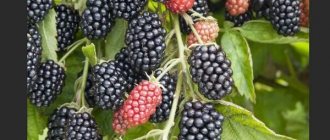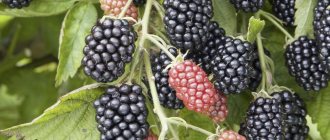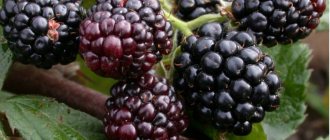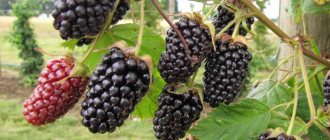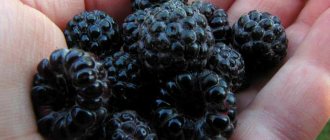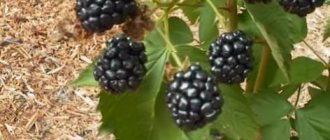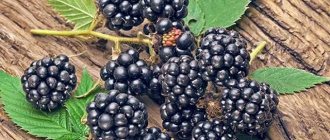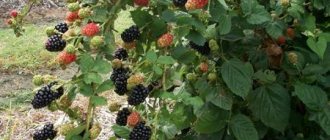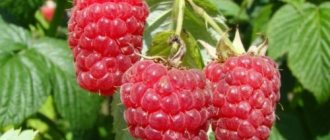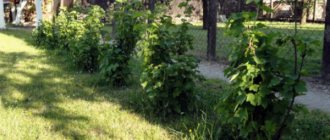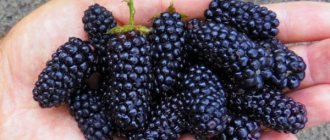Agavam blackberries: description and characteristics, reviews and photos, planting, cultivation and care, pruning
Currently, there are about 400 varieties of cultivated blackberries.
. It is significantly different from its predecessor, the wild berry. First of all, it has large, sweet and juicy berries. May not have thorns. There are remontant varieties.
Of course, unlike wild blackberries, cultivated ones require proper care, including obligatory shelter for the winter period. In this regard, there is a need for a variety that is not so demanding on care. Agavam blackberries are perfect for growing in garden plots.
But the opinion of gardeners about this variety is ambiguous.
The Agavam variety is definitely not suitable for “gourmet” gardeners.
, since it has small berries, the taste is ordinary, there are huge thorns on the stems, which interferes with picking. But there are also those who have been growing Agave for several seasons and are not going to change it to another. To understand the reason for this, it is worth taking a closer look at this Agawam blackberry variety, its characteristics, advantages and disadvantages, features of cultivation and care.
The content of the article:
1. History of selection 2. Description of the berry crop 3. General idea of the variety 4. Description of the berries 5. Characteristics of the Agawam variety 6. Flowering period and ripening time 8. Yield indicators 9. Area of application of the berries 10. Advantages and disadvantages 11. Cultivation of the variety 11.1 Recommended timing for planting Agawam blackberries 11.2 Selecting a suitable place for planting 11.3 Soil preparation 11.4 Selection and preparation of seedlings 11.5 Algorithm and scheme for planting Agawam blackberries 12. Further care of Agawam blackberries 12.1 How to improve the yield of the variety 12.2 Necessary measures 12.3 Pruning bushes 12.4 Preparing the hedgehog wiki Agawam for winter 13. Resistance to diseases and pests 14. Reviews of blackberries Agave
Landing Features
Like any plant, blackberries have their own planting characteristics, following which anyone can grow them in their own area.
Deadlines
It is better to plant the blackberry variety in question in the spring - this way the plant will have time to take root and develop in order to successfully survive the winter period. If it was not possible to plant seedlings in the spring and you postponed planting until the fall, then before the onset of cold weather you need to insulate them with any available suitable material (preferably of plant origin).
Did you know? According to recent studies, substances contained in blackberries can destroy cancer cells, inhibiting their development and without causing harm to healthy ones.
Selecting a location
It is best to choose an area that is constantly illuminated by the sun, but partial shade is also suitable. You should not plant blackberries in permanently shaded areas, as this will negatively affect the taste of the berries. The landing site can be either completely open or located near barriers or buildings.
Selection and preparation of planting material
Select seedlings that are 1–2 years old. They should be strong, with fresh leaves, without damage, spots or other signs of disease. It would be best to purchase seedlings from a nursery, where they will provide you with high-quality varietal material. Before planting, their roots need to be soaked in a special growth stimulator - this way the plants will better take root in their permanent location.
You will be interested to know what blackberries on your site get along with and what they don’t.
Planting scheme
After choosing a site for cultivation, suitable planting material and its preparation, you can proceed directly to planting the seedlings in a permanent place:
- Dig up the selected area and remove large clods of soil.
- At a distance of 2 m, dig holes measuring 40x40 cm with a depth of at least 0.6 m. If there is more than one row, then the distance from one to the other should be at least 2.5 m.
- Fill the holes with drainage made of small pebbles or broken bricks and cover with soil.
- Place the seedling in the hole and cover the roots with a mixture of humus and fertilizer.
- Add soil from above to the root collar.
- Water the soil.
- Place straw, dry leaves or aged manure around the trunk of the seedling.
- Trim the shoots so that 1-2 buds remain.
History of selection
Agawam has been around since the mid-19th century. Almost nothing is known about how it happened. The only thing that is known for sure is its place of origin - the United States of America. Originated from wild crops of North America. There are sources claiming that the first mention of Agawam dates back to 1865.
12 years ago, the variety was officially included in the state register of the country. Grown in any area.
Blackberry Agavam - photo
General idea of the variety
Agawam creates a compact and at the same time powerful bush
. The shoots have the shape of 5 sides, are quite dense and strong. The tops are slightly lowered. There are also brown thorns curved downwards. The spines are medium sized, sharp and hard. The shoots that have just begun to ripen are green. At the end of the growing season they acquire a dark, rich shade. The lashes left over from previous years are brown in color.
Interesting!
Agave blackberries are characterized by a certain shape of leaves, when all the plates originate at one point. In addition, there is a corrugation, an intense edge. Towards the end the leaf is usually very narrowed.
On the reverse side of the leaf plate, the veins located in the center have spines. They are much smaller than those located on the shoots. All leaves are medium in size and firmly attached to the vines. Even in winter, blackberries have powerful foliage.
The Agavam variety has an average ability to create and form shoots
. There is a lot of growth, it is almost useless to fight it.
Description of Agavam blackberries
Fruit weight from 4 to 5 grams, weak edge. The color is rich black, oval or slightly truncated cone shape. From 15 to 20 fruits ripen on each cluster.
Important!
Agaves need to be harvested on time. On a 5-point scale, Agavam blackberries deserved 3.5 points. At the same time, reviews about the variety are correspondingly different.
Ripe berries have a sweet and sour taste. There is a subtle, light aroma
. Since the fruits themselves are quite dense, they can easily withstand transportation over long distances. Those fruits that are overripe soften, become watery and taste bland.
When Agawam blackberries are only at the stage of technical ripeness, they have a herbaceous aroma. At this point there is no sourness in the taste yet.
Blackberry Agavam - video
Trimming
In the first years, Agavam blackberries do not require much effort to form. But having come into force, this variety begins to drive out vines that are too long, which can turn the plantation into a jungle. Therefore, starting from the fourth year of life, Agaves need to be trimmed regularly.
Apart from the autumn removal of fruit-bearing branches, Agawams are pruned twice per season. The first pruning is carried out in the spring. Having released the overwintered vines, they are carefully inspected. Living shoots have shiny brown bark, they are elastic and strong, not brittle. Frozen ones must be cut out immediately. For a good harvest, 4-6 branches are enough.
The second pruning is carried out in July on this year's substitute shoots using the pinching method - pinching the top by 7-10 cm. For brambles, this is a mandatory technique that stimulates fruiting the next year. On second-order shoots, when they grow back, the procedure is repeated.
Bushes with Agawam blackberries
Characteristics of the Agavam blackberry variety
Agawam belongs to one of the most frost-resistant varieties
. It does not require shelter at all when grown in areas such as Ukraine, Belarus, and central Russia. Resistantly withstands temperatures down to -25-30 degrees.
The relationship to elevated temperature is the opposite
. At high temperatures, the berries may bake. In this regard, in the south it is preferable to plant Agaves in a semi-shaded place. This will not affect yield indicators.
Undemanding to soil, unlike other blackberry varieties
. Grows and develops well in neutral soil. Capable of transporting over long distances. Over-ripening should not be allowed, because such berries are unsuitable for fresh consumption.
There are some difficulties in collecting berries, which consists of sharp thorns. Perhaps this is the only significant drawback.
Varieties of berries!
Blueberry Patriot Gooseberry Commander Blackberry Natchez
Reviews
The Agavam blackberry was developed more than a hundred years ago. The exact origin of the variety is unknown. It is believed that the variety was obtained by hybridization between various wild American species. The berries of this variety, when fully ripe, are very sweet, without acid. Unripe ones are more grassy than sour. The very name of the variety contains an association with the sweet fruits of agave.
Agave berries are small. Its average weight is 3 g, like most raspberry varieties. However, the yield is disproportionately higher. An adult five-year-old bush can produce more than 10 kg of berries. The bush of the plant is erect. Shoots can reach a length of 2.5 m. The ends of the shoots are drooping. If the variety is inferior in size to other varieties of cultivated blackberries, then this is one of the most frost-resistant varieties. Its shoots can tolerate temperatures down to –30 degrees C.
The berry is black, with a glossy sheen. The shape of the assembled drupe is in the form of a small elongated truncated cone. There are 10–12 berries in a berry cluster. The replacement shoots are powerful and faceted. The adult shoot has a round cross-section. At first the shoots are light green, by autumn they become reddish, then dark brown. The thorns on the shoot are sparse, but strong, slightly curved. There are also thorns along the central vein of the leaf blades, on the reverse side of the leaf.
The leaf of the plant is decorative. The leaf blades diverge in five rays from a common point, like a leaf of a maiden grape or horse chestnut. Each beam plate is quite large, shaped like a boat with a rounded stern and a very sharp bow, formed from two arcs converging with concave sides.
The plant blooms with large milky-white flowers collected in erect clusters. The bush blooms beautifully and wildly. The flowers in the brush spread out in all directions in a herringbone pattern. The berries ripen in early August.
This blackberry is practically not affected by diseases. Unlike many blackberries, it produces offspring with which it reproduces. It is also possible to propagate by apical layering if you artificially bend down the replacement shoots, but rooting does not go well. Only ten percent of the cuttings take root, and even those subsequently grow poorly. The root system of suckers is usually undeveloped. To obtain a standard seedling, it is necessary to grow it in a school.
Yakimov. From: Samara
https://club.wcb.ru/index.php?showtopic=63
Caring for blackberries is almost the same as caring for raspberries. While the bushes are small and have not yet bear fruit, shoots are not cut out. When fruiting begins, the fruit-bearing shoots (the shoots from which the harvest was harvested) are cut out every year after harvesting. They are cut immediately after collection. They leave replacement shoots, i.e., that will bear fruit next year. Replacement shoots emerge from the ground in May - June. Thus, the bush seems to be renewed every year. Fruiting has just begun on your bushes, a few berries are not a harvest, perhaps there are still flower buds on the shoots, so try leaving them for another summer.
It is imperative to cover the shoots remaining after cutting for the winter, regardless of frost resistance. Even if the variety is quite winter-hardy and the shoots do not freeze, the flower buds are more sensitive to frost, that is, a fairly developed bush ready for fruiting may not produce a harvest or produce only a few berries due to freezing of the flower buds. Judging by the fact that some of your bushes are powerful, they are ready to bear fruit. Not covering the bushes for the winter, if there is no snow in November and frosts are below -20 degrees C, can lead to freezing of the above-ground parts of some varieties.
Yakimov. From: Samara
https://club.wcb.ru/index.php?showtopic=63
Yes, Agavam is prickly. Yes, southern varieties will definitely be tastier in their south, larger and almost all without thorns. Just like apples, pears, grapes, apricots and everything, everything, everything. But for our conditions, for now this is the only variety that can be left uncovered in the fall and not be fooled about whether there will be a harvest next year or not. There will be a harvest. The tops will freeze and that's it. As for the taste of berries, as you know, there is no arguing about tastes. My Agawam is flying away. Children are climbing into thorns, nothing can stop them.
Hare. From: Moscow and Taldomsky district of Moscow region
https://forum.prihoz.ru/viewtopic.php?t=4856&start=150
My husband didn’t let me uproot the Agaves: he loves them more than raspberries. I got angry at the thorns. I read a lot of advertisements and decided to replace it with a thornless one, I got it from a neighbor because it was getting into her garden. She exchanged it with me for black raspberries and assured me that her blackberries were not covered. This fall I specifically went to her plot through the chain link and looked: all her blackberries were under spudbond. So I think it’s too early to clean up the Agaves. They do not seek good from good.
o-la-la. From: Moscow
https://forum.prihoz.ru/viewtopic.php?t=4856&start=150
Heated debates continue among gardeners about the advantages of raspberries over blackberries, and about the preference for growing modern thornless blackberry varieties over thorny ones. All this only makes me happy: it means there is a plot; there is something to plant it with; and there are those who are ready to consume what is grown on the site. During the season, everything is eaten, and the preparations are simply swept away!
Advantages and disadvantages
Despite the difference of opinions regarding the variety, Agavam has objective advantages:
- high yield rates;
- rapid growth of shoots;
- resistance to low temperatures, relative frost resistance, does not require shelter for the winter (in the central and southern zone of the country);
- ease of care;
- tolerates shade conditions well;
- undemanding to the composition of the soil;
- high protective properties against pests and diseases;
- the ability of the Agave blackberry bush to grow and bear fruit for more than 15 years;
- tested and tested by time.
Disadvantages of the Agavam variety
:
- the presence of thorns on shoots and leaves;
- the need to pick blackberries exactly on time;
- a huge amount of growth at the roots, which cannot be eliminated forever;
- small berry size.
The advantages far outweigh the disadvantages.
Blackberry Agavam: growing variety
Agave belongs to the mid-early varieties and this should be taken into account before planting and growing it in the future.
Growing blackberries from seeds
Recommended planting dates for Agawam blackberries
In the southern zone, Agavam blackberries are planted in the fall, about 30 days before the onset of frost.
In the north, it is worth planting Agava in the spring so that the earth warms up enough. Additionally, planting blackberries at this time will give them a chance to prepare for the cold winter.
Choosing a suitable place to plant blackberries
A distinctive feature of Agawam is that it can also be planted in low-lying areas. However, these should not be completely wetlands, despite its unpretentiousness and resistance to high humidity.
The variety tolerates neutral soil well. To avoid the occurrence of chlorosis, it is worth adding high-moor peat. This will help protect the crop from chlorosis, which cannot withstand high acidity.
A place with a predominance of partial shade, but nevertheless sufficiently illuminated and protected from drafts, is suitable for growing.
Soil preparation
For planting, it is necessary to follow certain rules, as well as soil preparation. This will make care much easier. For planting, you will need to make a planting hole with a depth and diameter of 50 cm.
The top layer of soil is combined with humus (a bucket is enough), fertilizers containing potassium and phosphorus (50 g and 120-150 g, respectively).
Depending on the initial condition of the soil:
- when density occurs, sand is added;
- for high acidity, add lime;
- for carbonate soil, add organic matter;
- with alkaline, neutral soil - acidic (high-moor) peat;
The resulting mixture must be mixed well, then fill the planting hole 2/3 full and then fill it with water.
Selection and preparation of seedlings
Finding and purchasing Agavam blackberries should not be difficult, since the variety is very common.
. It is important to pay attention to the development of the roots and the condition of the soil in which you purchase seedlings. There should be no cracks, wrinkles or damage on the shoots. The elasticity and flexibility of the shoots indicates their good quality.
Before planting blackberries in a permanent place of growth, the plant should be moistened. The root is placed in water.
Blackberry Agavam: algorithm and planting scheme
When placing blackberry bushes, be sure to maintain a distance of 2-3 meters from each other. When you plan to plant a larger number, you can plant more densely, with a distance of 1 to 1.5 meters.
Important!
If there are a huge number of thorns, it is still worth placing the bushes away from each other.
To plant blackberries, Agaves need to make a mound in the very center of the hole, carefully straighten the roots, sprinkling additional soil on top. After this, the soil is compacted and moistened again. At the very end, the ground is mulched.
The root neck is deepened by 1.5 - 2 cm.
Reproduction methods
Blackberries of the Agawam variety are propagated using numerous root shoots or seeds. Dividing a bush is the easiest way to obtain seedlings of a fruit crop. Shoots along with rhizomes are separated from an adult bush. Young seedlings are planted as individual plants.
Seeds are prepared from ripe berries.
- The berries are washed for a long time under running water until the seed material is completely cleared of pulp.
- Next, the seeds are placed in damp soil or sand and sent to the vegetable drawer in the refrigerator.
- The seeds are kept in the cold for 2-3 months, and only then they are planted in small containers filled with fertile soil.
- The pots are covered with film and sent to a warm place.
- As soon as the first shoots appear, the film is removed and the plants are planted in different pots.
In the spring, ready-made seedlings are planted in the open ground of a personal plot.
Further care for Agavam blackberries
Agawam shoots are quite long, reaching up to 3 meters in length. They must be tied up. The best option is a horizontal arrangement, at a distance of 25 cm from each other. Young shoots are tied in the same way.
How to improve the yield of the Agavam variety
Factors affecting yield:
- systematic watering, with a lack of moisture the berries become small;
- timely pruning of dry branches that no longer bear fruit;
- enough light.
To obtain a good harvest, it is necessary to apply fertilizing in a timely manner.Interesting!
Pumpkin PearlNecessary activities
First of all, watering should be carried out systematically, immediately after planting. In this case, watering is carried out 2 times every 7 days. The rest of the time, depending on the degree of drying of the soil.
In the spring, Agave blackberries are fertilized with nitrogen, and when the buds open, complex mineral fertilizer is used.
Planting and care
After the entire crop is harvested, potassium monophosphate is added to the soil. During periods of extreme heat, as well as during periods of rain or, conversely, severe drought, spraying with epin, as well as zircon, can be carried out in a sequence of 14 days. You can also add chelates so that the leaves do not turn yellow and are green.
In spring and autumn, it is worth loosening the soil. During flowering and fruiting, it is worth replacing it with mulching. The material you can use is peat and humus. This procedure will help retain moisture inside for a long time.
Agawam blackberry bush pruning
Pruning helps increase yield. In this case, in any case, regardless of whether it is worth covering the plant for the winter or not, it is worth pruning the shoots after harvesting the fruits. Agawam blackberries can be pruned in both fall and spring.
.
It is worth starting pruning after the blackberry reaches the age of 3 years, since it is in the 4th year that the shoots begin their full growth. Remove dry, broken branches, as well as lashes that are affected by the disease.
Pruning blackberry bushes in spring - video
On an adult blackberry bush, for further fruit formation, leave from 4 to 6 of the most powerful shoots
. During the process of growth and development, the tops of the shoots are cut off from the sides from 7 to 10 cm. This will lead to greater branching, and, accordingly, to the formation of more clusters with fruits.
Compared to other varieties, Agawam has a lot of growth
. However, no measures will help get rid of them. The only thing that remains is to regularly remove the growth on the surface of the earth.
Pruning Agavam blackberries is a mandatory and quite labor-intensive procedure.
Preparing Agavam blackberries for winter
In the south of the country, as well as in the middle zone, blackberries do not necessarily need to be covered
. Where shelter is necessary, it is recommended to choose other varieties. Imagine how difficult this procedure will be if you have to bend powerful and thorny stems. Quite problematic.
There is one option for covering Agawam blackberries using a trellis. In this case, the root is sprinkled with earth, the shoots are covered with agrofibre.
How to care for Avagam blackberries in autumn
Navajo blackberry: planting
If you properly care for the shrub, it will grow and bear fruit well within ten to fifteen years; this is largely influenced by where and how the planting was carried out. That is why planting and agricultural technology in the spring play a big role for the further development of blackberries and their yield.
Optimal time.
The recommended time for planting Navajo blackberries is the spring season; in the north, planting can be done in the first days of summer. Blackberries are not planted in the autumn season, because young bushes have poor tolerance to the winter period, especially long and harsh ones.
How to choose a suitable site.
The site for planting Navajo blackberries is selected to be well-lit by the sun and warm, however, a semi-shaded place is also allowed. It is forbidden to plant blackberries in the shade, as there will always be a lack of light and heat, because of this the fruits will be small and have a sour taste.
You can plant bushes on an open plain or on a small hill, next to fences, outbuildings, it is important that there is protection from strong gusts of wind and drafts
How to prepare the soil.
The plant is not picky about the type of soil, but the quality of the soil must be at a high level. It must necessarily be filled with nutrients, humus, light, loose, breathable and with a neutral level of acidity (a slightly elevated one is possible). Blackberries prefer moist soil, but not waterlogged, because excessively high humidity is prohibited, since in damp soil the root system can rot.
Preparation of the site for planting is carried out in the autumn or spring seasons. For this purpose, it is cleared of vegetation residues, dug up, and organic substances or minerals are added. A couple of days before planting, the soil is leveled with a rake and planting holes are dug.
How to select and prepare seedlings.
Choose seedlings that are healthy, undamaged, not affected by diseases, and well developed. They should have a strong root system and powerful shoots with green leaves. Planting material with dried roots or poorly growing vines is not suitable for planting. Before planting the bushes, the roots are moistened and placed in a solution of the Kornevin preparation to stimulate root formation. They are kept there for as long as indicated in the instructions.
Progress of planting work.
The interval between seedlings is at least one and a half to two meters. Planting holes should have a large volume: diameter and depth - sixty cm. When planting, humus (one bucket) and ash (two tablespoons) are poured into each hole. The top dressing is covered with a soil layer to prevent the roots from coming into contact with it.
Landing algorithm.
- The soil in the hole is moistened.
- The bush is installed in the center, the roots are straightened.
- The seedling is covered with soil to the level of the growth buds.
- The shoots are cut off, leaving two or three buds on each.
- The surface soil layer is mulched. For this purpose, hay, sawdust, straw or non-acidic peat are used.
- Place a strong trellis near each bush, and tie elongated lashes to it. Another method: supports are installed along the borders of the row, and between them a wire is stretched in two or three rows to support the bushes.
Further agricultural technology.
Caring for the variety is very simple. If planting is done correctly, then next year expect the first fruits to appear, and in the fourth year the bush will give a generous harvest. The main goal of the gardener during this period of time is to provide the blackberries with the required amount of water and fertilizing, to form bushes and prepare them for the winter season.
Agave blackberry resistance to diseases and pests
The Agavam blackberry variety has high resistance to pests and diseases.
. But it is important to collect berries in a timely manner, otherwise a disease such as gray rot may appear.
With the correct arrangement of nearby crops, for example, blackberries, raspberries, nightshades, it will practically not get sick. It is important to maintain distance between plants.
To prevent diseases in autumn and spring, Agava blackberries must be treated with preparations that contain copper.
.
Blackberry Agavam: reviews from those who grow the variety
Kristina, Rostov-on-Don: I have been growing the Avagam variety for several years in a row. I don’t plan to harvest the berries yet, since the harvest is very good every season. It is worth mentioning separately that it is necessary to protect from strong sun, as well as to carry out pruning in a timely manner. I especially like the taste of berries - sweet and juicy. You can make juices, confitures, and jams from them.
Evgeniy, Stavropol: A work colleague recommended this variety to me for cultivation. I did not immediately decide to grow the variety, since almost everywhere they talk about its thorniness. However, I decided to try to grow it anyway. Partly due to the fact that the culture does not require shelter. I did not regret choosing the Agave blackberry variety, as the fruits have a sweet-sour taste that I love. All berries look very aesthetically pleasing. Now I plan to plant more. It makes excellent wine from the berries. They are also good fresh.
Agave blackberries belong to the old varieties. However, it is not necessary to cover it - it is considered one of the most resilient and healthy,
today, since it is closely related to the wild crop. Those who have been growing it for several years are quite satisfied
